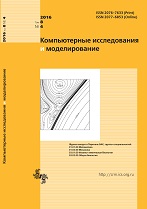|
This article is cited in 1 scientific paper (total in 1 paper)
NUMERICAL METHODS AND THE BASIS FOR THEIR APPLICATION
Efficient Pseudorandom number generators for biomolecular simulations on graphics processors
A. A. Zhmurovab, V. A. Barsegovab, S. V. Trifonova, Ya. A. Kholodova, A. S. Kholodova
a Moscow Institute of Physics and Technology (State University), Dolgoprudny, Moscow region
b Department of Chemistry, University of Massachusetts, Lowell, MA 01854
Abstract:
Langevin Dynamics, Monte Carlo, and all-atom Molecular Dynamics simulations in implicit solvent require a reliable source of pseudorandom numbers generated at each step of calculation. We present the two main approaches for implementation of pseudorandom number generators on a GPU. In the first approach, inherent in CPU-based calculations, one PRNG produces a stream of pseudorandom numbers in each thread of execution, whereas the second approach builds on the ability of different threads to communicate, thus, sharing random seeds across the entire device. We exemplify the use of these approaches through the development of Ran2, Hybrid Taus, and Lagged Fibonacci algorithms. As an application-based test of randomness, we carry out LD simulations of N independent harmonic oscillators coupled to a stochastic thermostat. This model allows us to assess statistical quality of pseudorandom numbers. We also profile performance of these generators in terms of the computational time, memory usage, and the speedup factor (CPU/GPU time).
Keywords:
GPU, pseudorandom numbers, PRNG, biomolecules.
Received: 21.07.2011
Citation:
A. A. Zhmurov, V. A. Barsegov, S. V. Trifonov, Ya. A. Kholodov, A. S. Kholodov, “Efficient Pseudorandom number generators for biomolecular simulations on graphics processors”, Computer Research and Modeling, 3:3 (2011), 287–308
Linking options:
https://www.mathnet.ru/eng/crm668 https://www.mathnet.ru/eng/crm/v3/i3/p287
|

| Statistics & downloads: |
| Abstract page: | 101 | | Full-text PDF : | 37 | | References: | 21 |
|




 Contact us:
Contact us: Terms of Use
Terms of Use
 Registration to the website
Registration to the website Logotypes
Logotypes








 Citation in format
Citation in format 
